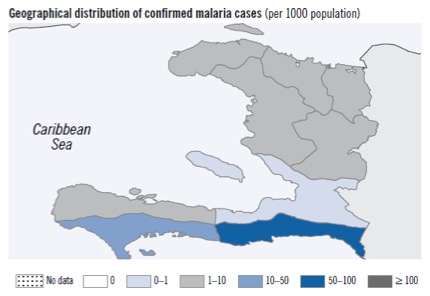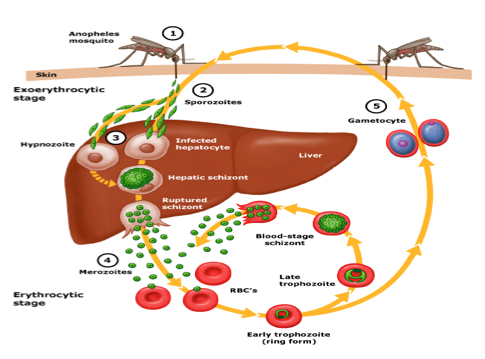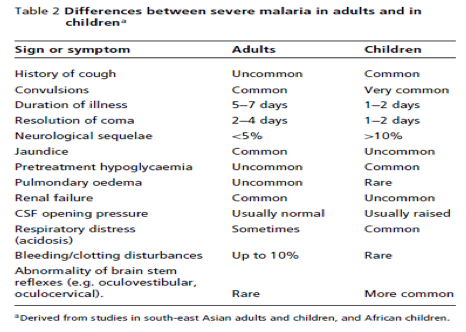
 Malaria is easily diagnosed. The 2 means in routine use at Hopital Sacre Coeur are microscopy and RDT (rapid diagnostic test). Microscopy relies on the preparation and examination of blood films to identify malarial parasites within red blood cells. This is considered the gold standard but requires appropriate training of laboratory personnel. RDTs are chemical tests which identify malarial proteins in a sample of blood. These tests are easy to use and require minimal training. Unfortunately, they are significantly more costly.
Malaria is easily diagnosed. The 2 means in routine use at Hopital Sacre Coeur are microscopy and RDT (rapid diagnostic test). Microscopy relies on the preparation and examination of blood films to identify malarial parasites within red blood cells. This is considered the gold standard but requires appropriate training of laboratory personnel. RDTs are chemical tests which identify malarial proteins in a sample of blood. These tests are easy to use and require minimal training. Unfortunately, they are significantly more costly.
Luckily, Haiti remains one of the few countries in the world where P.falciparum malaria may be treated with chloroquine. In most countries, chloroquine resistance is widespread. There is some preliminary data that chloroquine resistance is emerging in Haiti. Outpatient therapy with chloroquine is appropriate for patients with mild illness (minimal parasite loads, no significant organ dysfunction and able to maintain oral intake). For those with more severe illness, hospitalization and intravenous quinine therapy is necessary. If there is any doubt as to the degree of malaria severity, the patient’s care should always default to the more aggressive route. Untreated malaria can most certainly be fatal.
The treatment doses of chloroquine are:
• Adults: 600 mg base (=1000 mg salt) po immediately, followed by 300 mg base (=500 mg salt) po at 6, 24, and 48 hours. Total dose: 1500 mg base (=2500 mg salt).
• Children: 10 mg base/kg po immediately, followed by 5 mg base/kg po at 6, 24, and 48 hours. Total dose: 25 mg base/kg.
The treatment doses of quinine are:
• Loading dose: 20 mg salt/kg of body weight diluted in 10 ml isotonic fluid/kg by IV infusion over 4 hours
• Maintenance dose: 8 hours after the start of the loading dose, 10 mg salt/kg, over 4 hours.
• Repeat maintenance dose every 8 hours
 Chloroquine is also the appropriate prophylactic medication for travelers to Haiti. There are well documented cases of malaria occurring in US health care workers serving in Haiti after the earthquake. All visitors to Haiti are advised to follow the protocol:
Chloroquine is also the appropriate prophylactic medication for travelers to Haiti. There are well documented cases of malaria occurring in US health care workers serving in Haiti after the earthquake. All visitors to Haiti are advised to follow the protocol:
Chloroquine 500 mg by mouth weekly for 1 week prior to arrival, while in country and for 4 weeks after departure.
Visitors to Haiti are also advised to reduce their malaria risk by sleeping under mosquito nets, using insect repellants and wearing long pants/sleeves. However, even strict adherence to such measures does not guarantee immunity from malaria. Any traveler returning from Haiti should promptly report any fever to their physician.
In 2010, a Lancet Infectious Disease article advocated for the elimination of malaria in Haiti using the following strategy3:
• Elimination of the human reservoir via mass detection and treatment. This includes the active identification of asymptomatic cases.
• Prevention of transmission via use of mosquito nets, insecticide spraying and larval habitat destruction.
• Community mobilization to seek diagnosis and treatment of all fevers and to support the elimination effort.
In 2008, the Carter Center launched an initiative to eliminate malaria from both Haiti and the Dominican Republic.
Hopital Sacre Coeur is fully prepared to care for the malaria patient. Its laboratory staff can diagnose malaria both with microscopy or via the rapid diagnostic tests. Nurses and physicians were formally trained on malaria management during the Infectious Disease Seminar in November 2011. Both chloroquine and quinine are part of the HSC formulary.
References:
1. World Malaria Report 2010: Haiti.
2. Eisele TP. Prevalence of Plasmodium falciparum infection in rainy season, Artibonite Valley, Haiti 2006. Emerging Infectious Diseases 2007; 13: 1494-1496.
3. Keating J et al. Malaria elimination on Hispaniola. Lancet Infect Dis 2010; 10: 291-292.
4. WHO. Guidelines for the treatment of malaria, 2nd edition.









